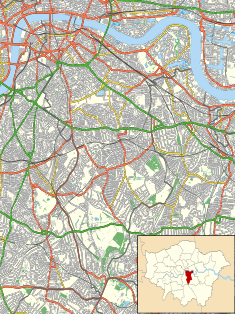
Southwark is a district of Central London situated on the south bank of the River Thames, forming the north-western part of the wider modern London Borough of Southwark. The district, which is the oldest part of South London, developed due to its position at the southern end of the early versions of London Bridge, the only crossing point for many miles.

Bermondsey is a district in South East London in the London Borough of Southwark, England, 2.5 miles (4.0 km) southeast of Charing Cross. To the west of Bermondsey lies Southwark, to the east Rotherhithe and Deptford, to the south Walworth and Peckham, and to the north is Wapping across the River Thames. It lies within the historic county boundaries of Surrey.
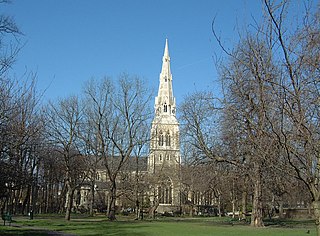
Camberwell is a district of South London, England, in the London Borough of Southwark, 2+3⁄4 miles southeast of Charing Cross.

The London Borough of Southwark in south London forms part of Inner London and is connected by bridges across the River Thames to the City of London and London Borough of Tower Hamlets. It was created in 1965 when three smaller council areas amalgamated under the London Government Act 1963. All districts of the area are within the London postal district. It is governed by Southwark London Borough Council.
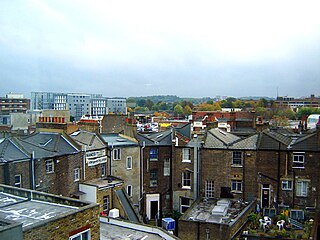
Peckham is a district of South London, England, within the London Borough of Southwark. It is 3.5 miles (5.6 km) south-east of Charing Cross. At the 2001 Census the Peckham ward had a population of 14,720.
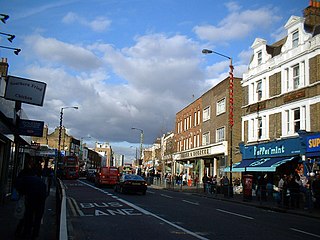
Walworth is a district of south London, England, within the London Borough of Southwark. It adjoins Camberwell to the south and Elephant and Castle to the north, and is 1.9 miles (3.1 km) south-east of Charing Cross.

Camberwell was a civil parish and metropolitan borough in south London, England. Camberwell was an ancient parish in the county of Surrey, governed by an administrative vestry from 1674. The parish was included in the area of responsibility of the Metropolitan Board of Works in 1855 and became part of the County of London in 1889. The parish of Camberwell became a metropolitan borough in 1900, following the London Government Act 1899, with the parish vestry replaced by a borough council. In 1965 the borough was abolished and its former area became part of the London Borough of Southwark in Greater London.

Nunhead is a suburb in the London Borough of Southwark in London, England. It is an inner-city suburb located 4 miles (6.4 km) southeast of Charing Cross. It is the location of the 52-acre (0.21 km2) Nunhead Cemetery. Nunhead has traditionally been a working-class area and, with the adjacent neighbourhoods, is currently going through a lengthy process of gentrification. Nunhead is the location of several underground reservoirs, built by the Southwark and Vauxhall Waterworks Company.

Shoreditch Town Hall is a municipal building in Shoreditch, London. It is a Grade II listed building.

Camden Town Hall, known as St Pancras Town Hall until 1965, is the headquarters of Camden London Borough Council. The main entrance is in Judd street with its northern elevation extending along Euston Road, opposite the main front of St Pancras railway station. It has been Grade II listed since 1996.

Islington Town Hall is a municipal facility in Upper Street, Islington, London. The town hall, which is the headquarters for Islington London Borough Council, is a Grade II listed building.

Fulham Town Hall is a municipal building on Fulham Road, Fulham, London. It is a Grade II* listed building.

Finsbury Town Hall is a municipal building in Finsbury, London. The structure is a Grade II* listed building.

The Old Town Hall, Richmond on Whittaker Avenue in Richmond, London is a former municipal building which from 1893 to 1965 served as the town hall for the Municipal Borough of Richmond.

Lewisham Town Hall is a municipal building in Catford Road, Lewisham, London. The oldest part of the facility, the curved municipal offices, which is the headquarters of Lewisham London Borough Council, is a Grade II listed building.

160 Tooley Street is a municipal facility in Tooley Street, Southwark, London. It is the headquarters of Southwark London Borough Council.
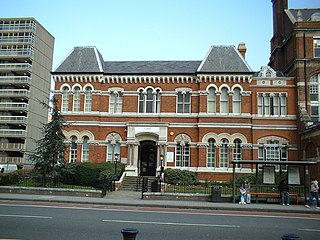
Walworth Town Hall is a municipal building in Walworth Road, Southwark, London. It is a Grade II listed building. It was built for the vestry of the parish of Newington, opening as the Newington Vestry Hall in 1865. When Newington became part of the Metropolitan Borough of Southwark in 1900 the building served as Southwark Town Hall. It ceased to be a headquarters of local government in 1965 when the London Borough of Southwark was created.

Bermondsey Town Hall is a municipal building in Spa Road, Bermondsey, London. It is a Grade II listed building.

Bethnal Green Town Hall is a former municipal building on the corner of Cambridge Heath Road and Patriot Square in Bethnal Green, London. It is a Grade II listed building.

Wandsworth Town Hall is a municipal building on the corner of the High Street and Fairfield Street in Wandsworth, London. The building, which is the headquarters of Wandsworth London Borough Council, is a Grade II listed building.

